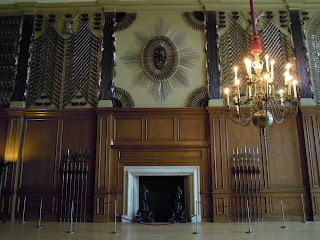Our Wednesday morning was spent learning about the British Inns of Court (which provide support for those training as Barristers), by visiting the Middle Temple Library. Incidentally, the four Inns of court are Middle Temple, Inner Temple, Lincoln's Inn, and Gray's Inn, and it is mandatory for barristers to belong to one. The library has 4 floors of books including a rare books and manuscript collection. It has existed in the location we toured only since 1958, as the previous library structure was bombed during the war and destroyed. Each Inn has a different focus, and here they center on subjects such as tax and insurance law along with ecclesiastical law. The library then caters to these subject areas with collections representing English as well as European and American law in forms ranging from texts, looseleafs, law biographies, and trial proceedings (which are hugely important as English law is based on precedent).


Middle temple has an especially large collection of American law materials owing to a Carnegie donation. There are further American connections as they have an exchange program with Pepperdine University. The American Ambassador is also traditionally an honorary member of this Inn. The library has a very clean look as none of the book's spines are labelled as they wanted to maintain the appearance of a gentleman's club
(No, not like that, that's how our guide referred to it, but think like a throwback private member club... ). They also have no classification system, so they have printed quick guides available for library users to assist with finding resources.
The non-library areas we toured were beautifully appointed with detailed ceilings, and carved wood paneling, and there are a few areas you might recognize if you're a romantic comedy fan - the hallway and one of the meeting rooms appeared in Bridget Jones's Diary films. The great hall here was also especially impressive as the head table was constructed from 4 huge continuous planks that arrived by being sent down the Thames, and the magnificent ceiling boasts a double hammer-beam roof which is twice as large and expensive to construct, and there are only 3 others like it.
Following our tour we discussed our research projects and went out for lunch as a group to the Old Bank of England Pub. It was all very academic... as we played word games with celebrity names while waiting for our food to arrive; hey, librarians get goofy too.
I returned to our residence after lunch and picked up my weasel, and we headed out taking a sunny stroll down Waterloo Road to the nearest Mail Boxes Etc. to seek passage home. This attempt proved futile, however, as the young woman who managed this particular location was quite taken aback by the "dead ferret," and was convinced no carrier would ship him. Since she then contacted all the shipping agencies and inquired as to the logistics of mailing a "dead ferret" it is no surprise that each service replied that they wouldn't accept it as it sounded like it would prove problematic for customs. She suggested I pack him in a box with peanuts, put the box in my suitcase and ship my clothing home instead. Assuring her that sounded like a 'great' plan (oh right, I can imagine them x-raying my suitcase...) I did purchase those materials and weasel and I returned, together, to my room.






























































